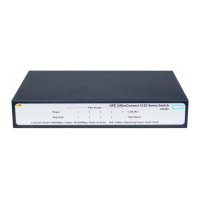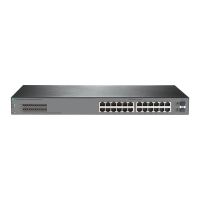179
Usage guidelines
When you use this command to shut down a VLAN interface, the VLAN interface remains in DOWN
(Administratively) state. In this case, the VLAN interface state is not affected by the state of the ports
in the VLAN.
Before you configure parameters for a VLAN interface, use this command to shut it down to prevent
the configuration from affecting the network. After you complete the VLAN interface configuration,
use the
undo shutdown command to make the settings take effect.
To troubleshoot a failed VLAN interface, you can use the
shutdown command and then the undo
shutdown
command on the interface to see whether it recovers.
In a VLAN, the state of each Ethernet port is independent of the state of the VLAN interface.
Examples
# Shut down VLAN-interface 2, and then bring it up.
<Sysname> system-view
[Sysname] interface vlan-interface 2
[Sysname-Vlan-interface2] shutdown
[Sysname-Vlan-interface2] undo shutdown
vlan
Use vlan vlan-id-list to create VLANs in batches, except reserved VLANs.
Use
vlan all to create VLANs 1 through 4094.
Use
undo vlan to delete the specified VLANs.
Syntax
vlan { vlan-id-list ] | all }
undo vlan { vlan-id-list | all }
Default
VLAN 1 (system default VLAN) exists.
Views
System view
Predefined user roles
network-admin
Parameters
vlan-id-list: Specifies a space-separated list of up to 32 VLAN items. Each item specifies a
VLAN or a range of VLANs in the form of vlan-id1
[ to vlan-id2 ]. The value for vlan-id2 must be
equal to or greater than the value for vlan-id1. The value range for the
vlan-id argument is 1 to
4094.
all: Specifies all VLANs except reserved VLANs. The keyword is not supported when the maximum
number of VLANs that can be created on a device is less than 4094.
Usage guidelines
You cannot create or delete the system default VLAN (VLAN 1) or reserved VLANs.
Before you delete a dynamic VLAN or a VLAN locked by an application, you must first remove the
configuration from the VLAN.

